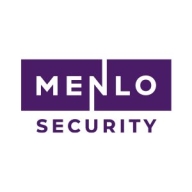

Menlo Secure and Fortinet FortiProxy are major players in the cybersecurity domain. Menlo Secure has an edge with its strong focus on cloud security and user-friendly features, which is particularly appealing for organizations seeking simplified management.
Features: Menlo Secure incorporates robust web isolation, phishing protection, and a cloud-first strategy for securing web traffic. Fortinet FortiProxy is equipped with advanced threat protection, granular web traffic control, and DNS-based threat filtering, supporting comprehensive network security management.
Room for Improvement: Menlo Secure could enhance its logging capabilities, allow for fewer site exemptions from isolation, and improve monitoring of encrypted traffic without compromising security. Fortinet FortiProxy might benefit from streamlining its complexity, reducing initial setup time, and enhancing user training to better leverage its extensive features.
Ease of Deployment and Customer Service: Menlo Secure is appreciated for its straightforward cloud deployment, allowing quick adoption with minimal hassle. Fortinet FortiProxy, while more complex and resource-intensive during the initial setup, provides strong support for on-premises deployments and robust customer service to aid businesses during implementation.
Pricing and ROI: Menlo Secure offers attractive pricing for cloud solutions with the promise of rapid ROI and reduced upfront costs. In contrast, Fortinet FortiProxy comes with higher initial setup costs due to its extensive security features but offers significant long-term ROI by minimizing security breaches and safeguarding data effectively.


Fortinet FortiProxy is a secure web gateway that provides advanced web filtering, malware protection, and SSL inspection capabilities. It is designed to protect organizations from web-based threats and prevent data loss by enforcing granular policies for web access. FortiProxy is available as a physical or virtual appliance and can be deployed on-premises or in the cloud. FortiProxy uses a combination of signature-based and behavior-based detection techniques to identify and block known and unknown threats. It also includes advanced features such as sandboxing and machine learning to detect and prevent zero-day attacks. FortiProxy can inspect SSL traffic to detect and block threats hidden in encrypted traffic. FortiProxy provides granular control over web access by allowing administrators to create policies based on user identity, device type, time of day, and other factors. It also includes pre-defined categories for web filtering, such as social media, gambling, and adult content. FortiProxy can also enforce compliance with regulatory requirements such as GDPR and HIPAA. FortiProxy integrates with Fortinet's Security Fabric, allowing it to share threat intelligence with other Fortinet products and provide a coordinated response to threats. It also includes a web-based management console that provides real-time visibility into web traffic and allows administrators to quickly respond to security incidents.
Fortinet FortiProxy is a comprehensive web security solution that provides advanced protection against web-based threats and allows organizations to enforce granular policies for web access.
Menlo Security Secure Application Access
Menlo Security Secure Application Access makes zero trust access easy, giving users secure connectivity to private applications, including web and legacy applications. At the core of Secure Application Access is the Menlo Secure Cloud Browser, which fetches, secures and delivers the content for users.
In addition to providing simple-to-deploy, clientless ZTA, Secure Application Access and the Menlo Secure Cloud Browser protect applications from attacks such as session hijacking, cookie manipulation, and other tactics that employ protocol manipulation.
Secure Application Access protects applications from Internet threats and provides granular controls for added protection of the application and associated data. These security controls include Read-only/Read-write, Upload/download, Copy/paste, AV scanning, Sandboxing, and Data Loss Prevention.
Last Mile Data Protection
Menlo Last-Mile Data Protection identifies and prevents sensitive data from leaving your company by meticulously inspecting all file uploads and user input across browsing sessions. Leveraging the Secure Cloud Browser, users are protected from the internet and you can protect your organization from data loss with comprehensive traffic monitoring and controls. This approach addresses the growing concerns surrounding data leakage in the age of AI tools like ChatGPT.
By identifying sensitive data through file types, regular expressions, or predefined libraries, Menlo Last-Mile Data Protection empowers security teams to regulate data input into AI platforms and prevent unauthorized uploads. This capability provides crucial protection for intellectual property, PII, and other confidential information.
The solution leverages the Menlo Cloud Security Platform's visibility and control over traffic to reliably detect and prevent data leaks originating from both browser submission forms and non-browser traffic. With the ability to inspect encrypted web traffic, Menlo Last-Mile Data Protection enforces DLP policies consistently across all users and devices, ensuring comprehensive data protection.
We monitor all Secure Web Gateways (SWG) reviews to prevent fraudulent reviews and keep review quality high. We do not post reviews by company employees or direct competitors. We validate each review for authenticity via cross-reference with LinkedIn, and personal follow-up with the reviewer when necessary.